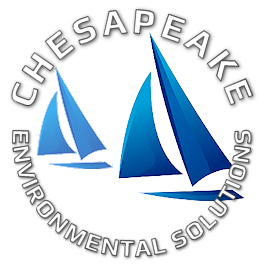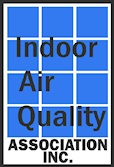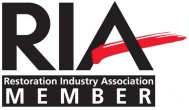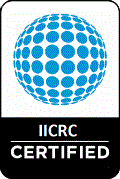Frequently Asked Questions About Mold
Questions? Give us a call at 410-286-0234410-286-0234.
- What causes mold to develop?
- How does mold get into a building?
- Are there harmful and non-harmful molds?
- Does mold affect everyone the same way?
- How much mold exposure is harmful?
- Can mold exposure cause brain damage or death?
- Does tighter building construction promote mold development?
- Do new building materials (e.g. drywall or paper faced gypsum board) promote mold growth?
- Are there reliable tests to indicate the presence of mold?
- If mold is present, what’s the best way to get rid of it?
- Is it possible to completely eliminate mold from the inside of a home or office building?
- Should I use bleach to get rid of mold?
- How do I know when the mold clean up is finished?
- Where can I find more information on mold?
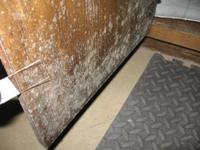
Mold requires nutrients, water, oxygen and favorable temperatures to grow. Nutrients for mold are present in dead organic material such as wood, paper or fabrics; mold can also derive nutrients from some synthetic products such as paints and adhesives. Mold requires moisture, although some mold species can obtain that moisture from moist air when the relative humidity is above 70 per cent. Many molds thrive at normal indoor temperatures; few if any molds are able to grow below 40 F or above 100 F. Outside this range molds may remain dormant or inactive; they may begin to grow again when the temperature is more favorable. Temperatures well above 100 F will kill mold and mold spores, but the exact temperature required to kill specific species is not well established.
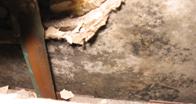
Molds are decomposers of organic material such as wood, plants and animals. Mold and mold spores are found in high concentrations wherever there is dead matter such as a pile of leaves, manure or compost. Mold spores enter buildings through the air or on people, animals and objects that are brought into the building. Spores are small bundles of genetic material and chemicals (similar to seeds) that molds make under certain conditions.
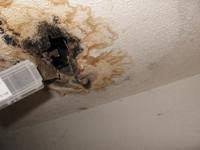
There are only a few molds that can cause infection in healthy humans. Some molds cause
infections only in people with compromised immune systems. The biggest health problem from
exposure to mold is allergy and asthma in susceptible people. There are more than 100,000
types of mold. Good information has been developed for only a small number of these molds –
at least in terms of their effects on human health. Most people tolerate exposure to
moderate levels of many different molds without any apparent adverse health effects.
Some molds produce powerful chemicals called “mycotoxins” that can produce illness in
animals and people. Scientific knowledge about the health effects of these toxins on humans
is quite limited.

No. Some individuals have a genetic makeup that puts them at risk for developing allergies to mold. People who have an allergy to mold, especially if they also have asthma, can become ill from exposure to a small amount of mold. Individuals also seem to be quite different in their response to exposure to the toxic chemicals that some molds release. These differences between individuals contribute to the difficult question of determining safe exposure limits for mold.
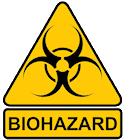
Each person’s personal exposure level is different and the United States does not have a standardized threshold for exposure. Individuals are very different with respect to the amount of mold exposure they can tolerate. Children under the age of one, year may be more susceptible to the effects of some molds than older individuals. Measuring or estimating "exposure" levels is very difficult. “Exposure” means the amount of mold (microscopic spores and mold fragments) that gets into a person usually by breathing, but also by eating or absorption through the skin. For example, a building may have a lot of mold in the walls but very little of that mold is getting into the air stream. In that case the people working or living in that building would have little mold exposure.

Some “experts” claim that individuals have brain damage or have died because of exposure to mold and especially mold toxins. Although much discussion surrounds this issue, judges and juries have been convinced that this is true and have awarded large settlements as a result. The prudent course of action would be to limit one’s exposure to really moldy environments. By “really moldy” we mean where there are large visible areas of mold (more than a few square feet) or the building has a “musty” odor because of hidden mold growth. There are many epidemiological studies showing that people who live in houses with dampness have many more health problems, especially respiratory, than do people who live in dry houses. This association does not “prove” that it is the mold that is responsible for the increase in illness. However, it does support the assertion that it is not wise to live in damp, moldy buildings.
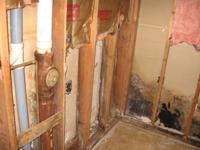
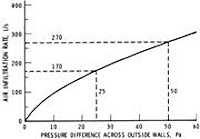
Tighter building construction does not by itself promote mold growth, but tight
construction combined with some poor choices in design, building materials or operations can
increase the probability of mold growth. What do we mean? The tighter the building
construction the less air exchange there is between the inside air and the outside air.
Whatever gets into the inside air stays there longer than it would in a house with loose
construction. Moisture that gets into the air from activities such as cooking, bathing and
even breathing will remain in a tight house longer than it would in a loose house. That’s
why exhaust fans should be installed in bathrooms and kitchens and vented to the outside.
Clothes dryers should also be vented to the outside.
Tight construction
permits control of the air exchange between the inside and the outside and can prevent the
deposition of moisture in walls and roofs. Controlling moisture, including indoor relative
humidity is the key to preventing mold growth. Tight building construction when combined
with source control of moisture (exhaust fans) and controlled ventilation (intentional
introduction of outside air) reduces the probability of mold growth in a building.
Controlled ventilation can be provided by a duct that brings outside air to the return side
of the air handler of a forced air system. A timing device or fan cycler can be programmed
to have the air handler turn on for a specified number of minutes each hour even when there
is no call for heating or cooling. In cold climates controlled ventilation is frequently
provided by a heat recovery ventilator (HRV).
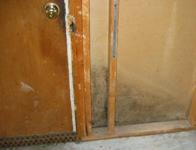
Mold needs water, a nutrient source, oxygen and favorable temperatures to grow. Many species of mold love paper faced gypsum board. Why? Making paper involves the mechanical and chemical processing of wood. Paper is largely pre-digested so it is easy for mold to get nutrients from the paper. But unless there is enough moisture present mold can’t grow on the paper. If paper faced gypsum board is kept dry, it can be used and still not have mold. This material is kept dry by controlling the interior relative humidity, keeping rain from entering roofs and walls, and NOT using paper faced gypsum in areas that are likely to get wet. This means nopaper faced gypsum board in shower and tub areas. Cement board, mortar or non-paper faced gypsum can safely be used in these damp areas because these products do not contain nutrients to support mold growth.

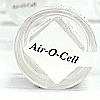
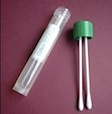
Almost all of us already have two effective mold detectors: our eyes and our noses. If
black or green discoloration is noticed that is fuzzy in appearance and is in a location
that is damp or had been damp, it is almost certainly mold. If a building smells musty,
there probably is mold somewhere; the mold may be on boxes stored in a basement or in walls
or in the crawl space. If you want to find mold, look for the presence of water or a
location where water was likely to have been. If there is still any question about whether
the black stuff is mold, have a reliable laboratory examine the material. All you need to
know is whether mold is seen when the material is examined under the microscope.
Surface and/or air sampling for mold should be done to obtain an answer to a question that
cannot be answered without the test(s). While real estate agents, lawyers, governments and
homeowners often like to no what’s floating around in their air, we can tell you that as a
general rule the Center for Disease Control (CDC), the U.S. Environmental Protection Agency
(EPA) and the American Conference of Governmental Industrial Hygienists do not recommend
routine air testing for mold. Each case is different and a reputable environmental
consultant will be able to advise if you should have a sampling survey done.
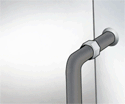
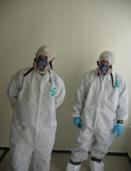
The answer depends on how much mold is present and where it is located. If the mold is on
furnishings or boxes simply discard the materials. Moldy materials are not considered
hazardous waste; they can be sent to a regular landfill. However, it is smart to seal the
moldy material in heavy plastic to protect the people who handle it in transit and prevent
spreading large amounts of the mold into the building as you carry the material out of it.
If the mold is on a hard surface but occupies less than 10 square feet wash
and/or scrub the area with soapy water (contrary to popular belief do not use bleach) rinse
and allow the area to dry before repainting. If you have asthma, severe allergies and a
weaken immune system get someone else to do the clean up.
Larger areas
(greater than 10 square feet in area) should be cleaned by a professional who has experience
doing this type of work. Remember, determine what caused the moisture problem and correct
that problem. A competent environmental consultant will advise you not only on the correct
way to clean it up, but why it is there in the first place.
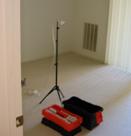
The answer is basically no. As mold exists naturally in the environment it would be
virtually impossible to eliminate all mold spores in your home or office. To keep a building
completely free of mold spores requires very efficient air filtration and is only
accomplished in special situations such as hospital operating rooms and manufacturing “clean
rooms.” Remember, mold spores are microscopic and in the outside air virtually all the time.
Some will get inside your home or office.
However, it is possible to keep mold
from growing inside a building. Moisture control is the key to controlling mold in interior
spaces. Air filtration can contribute to lowering mold spores in the air but is secondary to
moisture control.
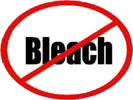
No. Although bleach can kill and decolorize mold, it does not remove it. Dead mold can still cause allergic reactions. It is not necessary to kill mold to remove mold. Soap and water and scrubbing can remove mold from hard surfaces. The Environmental Protection Agency (EPA), the Center for Disease Control (CDC) and the New York City Health Department agree that bleach or other biocides should not routinely be used to clean up mold.
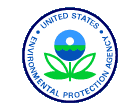
The mold cleanup is finished when there is no visible mold remaining and there is no dust or dirt remaining that could contain large amounts of mold and mold spores. Routine clearance testing for mold may or may not be required. Leaving a few mold spores behind is usually not a problem if the underlying moisture problem has been corrected. Remember that mold spores are virtually everywhere. Even if all mold and mold spores are removed as part of the cleanup, spores from outside will re-enter that space. The spores won’t be able to grow unless water is also present.
The EPA is a good source for more information about mold.
